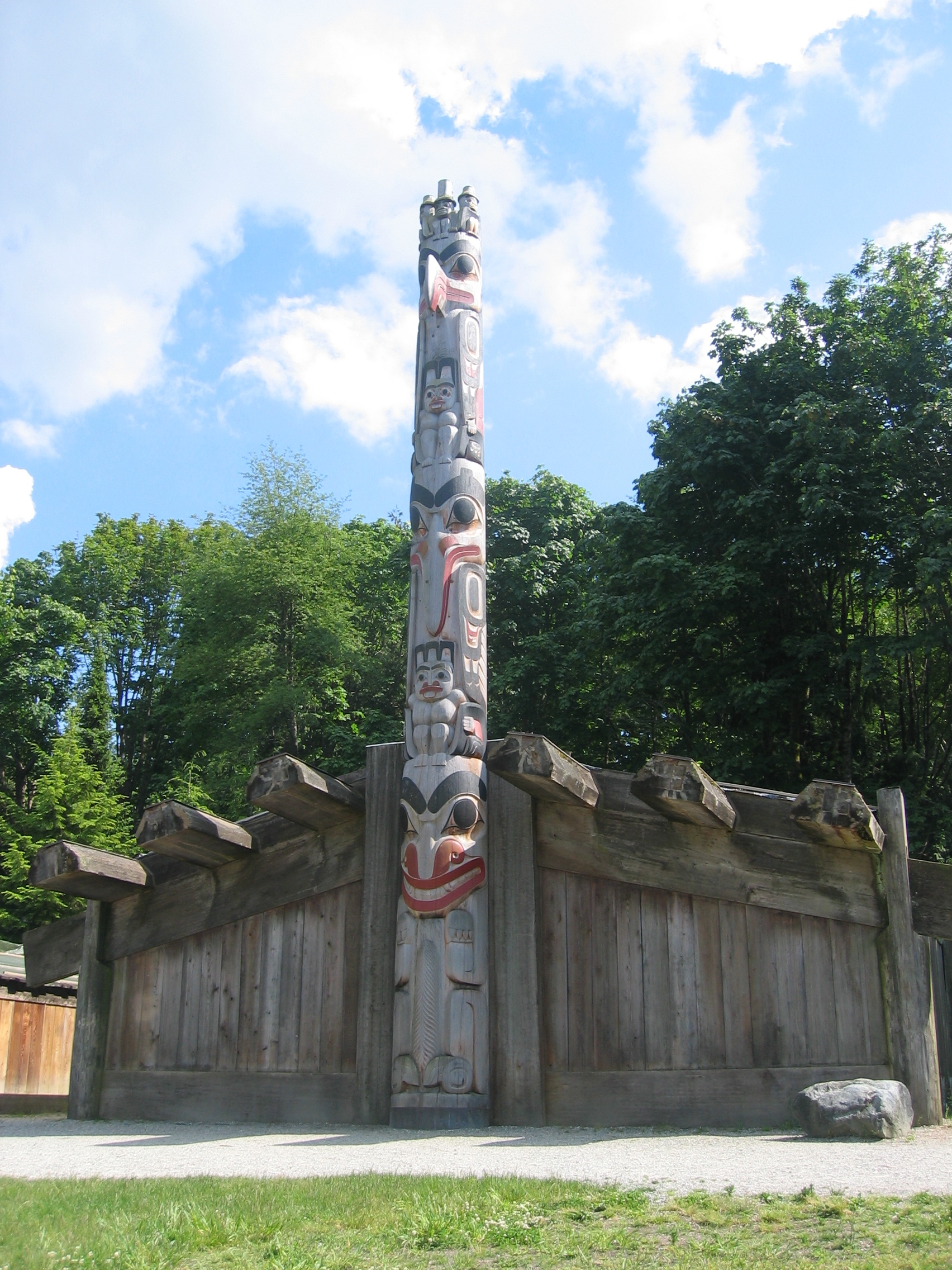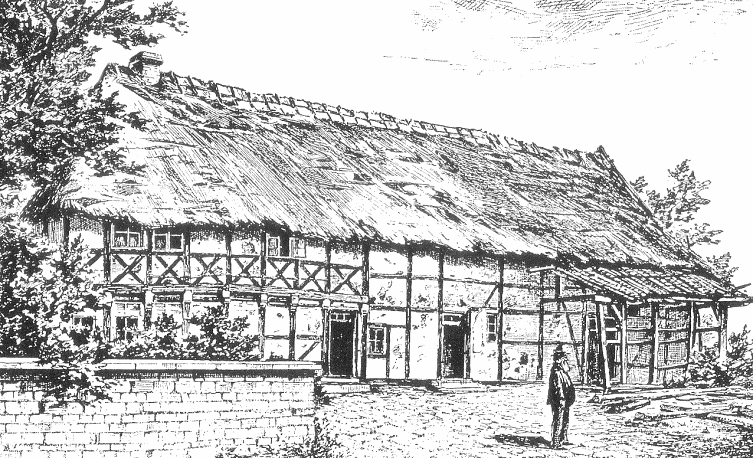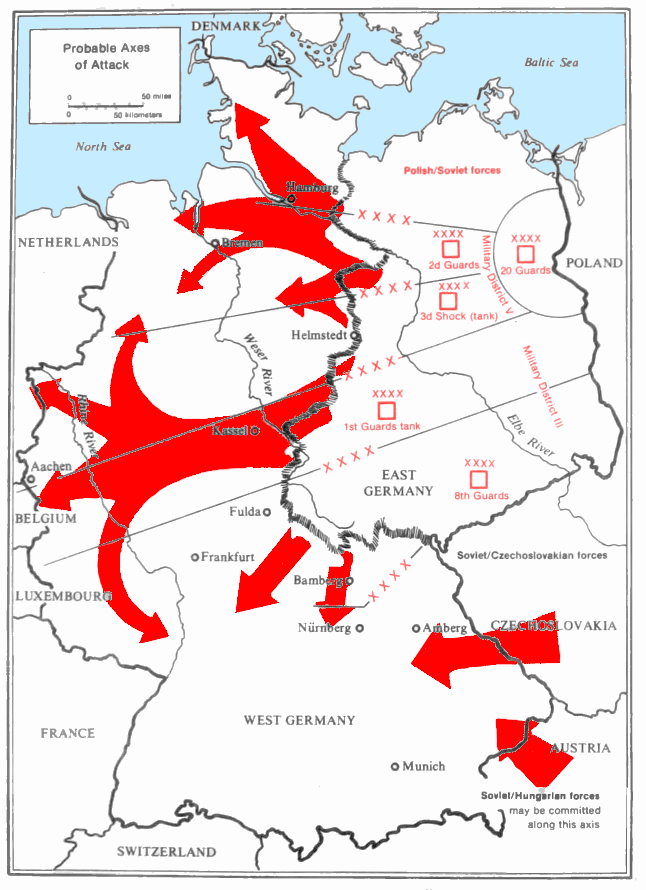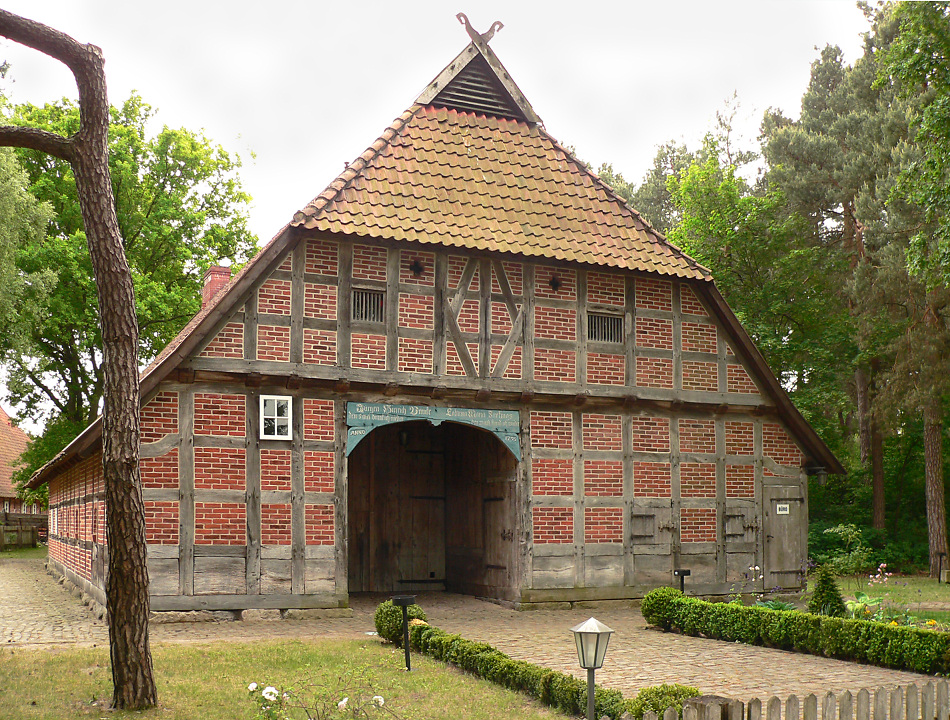|
Byre-dwelling
A byre-dwelling ("byre"+ "dwelling") is a farmhouse in which the living quarters are combined with the livestock and/or grain barn under the same roof. In the latter case, the building is also called a housebarn in American English. This kind of construction is found in archaeological sites in northwestern Europe from the Bronze Age. It was also used in more modern times by Mennonites, originating from the Netherlands. Distribution Austria The Bregenzerwälderhaus from the Bregenz Forest in Vorarlberg is an example for a byre-dwelling. The stable and the usually two-storey house are under one roof. Germany The generic German term is ''Wohnstallhaus'' from ''Wohnung'' ("dwelling"), ''Stall'' ("byre", "sty)" and ''Haus'' ("house"). From the Iron Age onwards the longhouse, developed from the byre-dwellings of the Bronze Age with its domestic area and adjacent cattle bays, was found across the North German Plain. As a result of the keeping of ever larger herds of cattle, ... [...More Info...] [...Related Items...] OR: [Wikipedia] [Google] [Baidu] |
Longhouse
A longhouse or long house is a type of long, proportionately narrow, single-room building for communal dwelling. It has been built in various parts of the world including Asia, Europe, and North America. Many were built from lumber, timber and often represent the earliest form of permanent structure in many cultures. Types include the Neolithic long house of Europe, the Norman Medieval Longhouses that evolved in Western Britain (''Tŷ Hir'') and Northern France (''Longère''), and the Longhouses of the indigenous peoples of North America, various types of longhouse built by different cultures among the indigenous peoples of the Americas. Europe The Neolithic long house type was introduced with the first farmers of Central Europe, Central and Western Europe around 5000 BCE, 7,000 years ago. These were farming settlements built in groups of six to twelve longhouses; they were home to large extended families and kin. The Germanic cattle-farmer longhouses emerged along the southw ... [...More Info...] [...Related Items...] OR: [Wikipedia] [Google] [Baidu] |
Middle German House
The Middle German house () is a style of traditional German farmhouse which is predominantly found in Central Germany. It is known by a variety of other names, many of which indicate its regional distribution: * ''Ernhaus'' (hall house, hall kitchen house) * ''Oberdeutsches Haus'' (Upper German house) * ''Thüringisches Haus'' (Thuringian house) * ''Fränkisches Haus'' (Franconian house) The Middle German house first emerged in the Middle Ages as a type of farmhouse built either using timber framing or stone. It is an 'all-in-one' house (''Einhaus'') with living quarters and livestock stalls under one roof. This rural type of farmstead still forms part of the scene in many villages in the central and southern areas of Germany. The northern boundary of its distribution area is roughly where the Central Uplands merge into the North German Plain. There, its place is gradually taken by the Low German house (''Fachhallenhaus''), known colloquially as the ''Niedersachsenhaus'' ( Lo ... [...More Info...] [...Related Items...] OR: [Wikipedia] [Google] [Baidu] |
Housebarn
A housebarn (also house-barn or house barn) is a building that is a combination of a house and a barn under the same roof. Most types of housebarn also have room for livestock quarters. If the living quarters are only combined with a byre, whereas the cereals are stored outside the main building, the house is called a byre-dwelling. Styles There are several styles of housebarns. One style is a building where the barn portion shares a wall with the house portion. Sometimes the house portion will extend into part of the loft on the second storey of the barn portion. Another style features the barn as the lower portion of the building and the house as the second floor such as the Black Forest house, Black Forest-style house. Similarly but for different reasons, some defensive house structures such as the bastle house and some tower houses combine animals on the ground floor and living quarters above, a security measure against Raid (military), raids. For example, bastle houses ar ... [...More Info...] [...Related Items...] OR: [Wikipedia] [Google] [Baidu] |
North German Plain
The North German Plain or Northern Lowland () is one of the major geographical regions of Germany. It is the German part of the North European Plain. The region is bounded by the coasts of the North Sea and the Baltic Sea to the north, Germany's Central Uplands (''die Mittelgebirge'') to the south, by the Netherlands to the west and Poland to the east. In the west, the southern boundary of the North German Plain is formed by the Lower Saxon Hills: specifically the ridge of the Teutoburg Forest, the Wiehen Hills, the Weser Hills and the Lower Saxon Börde, which partly separate it from that area of the Plain known as the Westphalian Lowland. Elements of the Rhenish Massif also act a part of the southern boundary of the plain: the Eifel, Bergisches Land and the Sauerland. In the east the North German Plain spreads out beyond the Harz Mountains and Kyffhäuser further to the south as far as the Central Saxon hill country and the foothills of the Ore Mountains. Landscape, soil ... [...More Info...] [...Related Items...] OR: [Wikipedia] [Google] [Baidu] |
Rhine
The Rhine ( ) is one of the List of rivers of Europe, major rivers in Europe. The river begins in the Swiss canton of Graubünden in the southeastern Swiss Alps. It forms part of the Swiss-Liechtenstein border, then part of the Austria–Switzerland border, Swiss-Austrian border. From Lake Constance downstream, it forms part of the Germany-Switzerland border, Swiss-German border. After that the Rhine defines much of the Franco-German border. It then flows in a mostly northerly direction through the German Rhineland. Finally, the Rhine turns to flow predominantly west to enter the Netherlands, eventually emptying into the North Sea. It drains an area of 185,000 km2. Its name derives from the Gaulish language, Gaulish ''Rēnos''. There are two States of Germany, German states named after the river, North Rhine-Westphalia and Rhineland-Palatinate, in addition to several districts of Germany, districts (e.g. Rhein-Sieg-Kreis, Rhein-Sieg). The departments of France, department ... [...More Info...] [...Related Items...] OR: [Wikipedia] [Google] [Baidu] |
Central Uplands
The Central UplandsDickinson (1964), p.18 ff. (N.B. In German die ''Mittelgebirge'' (plural) refers to the Central Uplands; das ''Mittelgebirge'' refers to a low mountain range or upland region (''Mittel'' = "medium" and ''-gebirge'' = "range").) is one of the three major natural regions of Germany. It stretches east to west across the country. To the north lies the North German Plain or Northern Lowland; to the south, the Alps and the Alpine Foreland. Formation The German Central Uplands, like the Scandinavian and British mountain ranges and the Urals, belong to the oldest mountains of Europe, even if their present-day appearance has only developed relatively recently. In the Carboniferous, i.e. about 350 million years ago, Variscan mountain ranges were formed in central Europe by the uplifting caused by tectonic plate collision. Immediately after their formation the erosion of the mountains began under the influence of exogenous processes during the Permian period. During ... [...More Info...] [...Related Items...] OR: [Wikipedia] [Google] [Baidu] |
Bay Of Gdansk
A bay is a recessed, coastal body of water that directly connects to a larger main body of water, such as an ocean, a lake, or another bay. A large bay is usually called a ''gulf'', ''sea'', ''sound'', or ''bight''. A ''cove'' is a small, circular bay with a narrow entrance. A ''fjord'' is an elongated bay formed by glacial action. The term ''embayment'' is also used for , such as extinct bays or freshwater environments. A bay can be the estuary of a river, such as the Chesapeake Bay, an estuary of the Susquehanna River. Bays may also be nested within each other; for example, James Bay is an arm of Hudson Bay in northeastern Canada. Some large bays, such as the Bay of Bengal and Hudson Bay, have varied marine geology. The land surrounding a bay often reduces the strength of winds and blocks waves. Bays may have as wide a variety of shoreline characteristics as other shorelines. In some cases, bays have beaches, which "are usually characterized by a steep upper foreshore wit ... [...More Info...] [...Related Items...] OR: [Wikipedia] [Google] [Baidu] |
North Germany
Northern Germany (, ) is a linguistic, geographic, socio-cultural and historic region in the northern part of Germany which includes the coastal states of Schleswig-Holstein, Mecklenburg-Vorpommern and Lower Saxony and the two city-states Hamburg and Bremen. It contrasts with Southern Germany, Western Germany, and Eastern Germany. Language Northern Germany generally refers to the ''Sprachraum'' area north of the Uerdingen and Benrath line isoglosses, where Low German dialects are spoken. These comprise the Low Saxon dialects in the west (including the Westphalian language area up to the Rhineland), the East Low German region along the Baltic coast with Western Pomerania, the Altmark and northern Brandenburg, as well as the North Low German dialects. Although from the 19th century onwards, the use of Standard German was strongly promoted especially by the Prussian administration, Low German dialects are still present in rural areas, with an estimated number of five to eight mi ... [...More Info...] [...Related Items...] OR: [Wikipedia] [Google] [Baidu] |
Low Saxon House
The Low German house or ''Fachhallenhaus'' is a type of timber-framed farmhouse found in northern Germany and the easternmost Netherlands, which combines living quarters, byre and barn under one roof. It is built as a large hall with bays on the sides for livestock and storage and with the living accommodation at one end. The Low German house appeared during the 13th to 15th centuries and was referred to as the Low Saxon house (''Niedersachsenhaus'') in early research works. Until its decline in the 19th century, this rural, agricultural farmhouse style was widely distributed through the North German Plain, all the way from the Lower Rhine to Mecklenburg. Even today, the ''Fachhallenhaus'' still characterises the appearance of many north German villages. Name The German name, ''Fachhallenhaus'', is a regional variation of the term ''Hallenhaus'' ("hall house", sometimes qualified as the "Low Saxon hall house"). In the academic definition of this type of house the word ''Fac ... [...More Info...] [...Related Items...] OR: [Wikipedia] [Google] [Baidu] |
Hall House
The hall house is a type of vernacular house traditional in many parts of England, Wales, Ireland and lowland Scotland, as well as northern Europe, during the Middle Ages, centring on a hall. Usually timber-framed, some high status examples were built in stone. Unaltered hall houses are almost unknown. Where they have survived, they have almost always been significantly changed and extended by successive owners over the generations. Origins In Old English, a "hall" is simply a large room enclosed by a roof and walls, and in Anglo-Saxon England simple one-room buildings, with a single hearth in the middle of the floor for cooking and warmth, were the usual residence of a lord of the manor and his retainers. The whole community was used to eating and sleeping in the hall. This is the hall as Beowulf understood it. Over several centuries the hall developed into a building which provided more than one room, giving some privacy to its more important residents. A significant house ... [...More Info...] [...Related Items...] OR: [Wikipedia] [Google] [Baidu] |
Post In Ground
A post in ground construction, also called earthfast or hole-set posts, is a type of construction in which vertical, roof-bearing timbers, called Post (structural), posts, are in direct contact with the ground. They may be placed into excavated postholes, driven into the ground, or on sills which are set on the ground without a foundation. Earthfast construction is common from the Neolithic architecture, Neolithic period to the present and is used worldwide. Post-in-the-ground construction is sometimes called an "impermanent" form, used for houses which are expected to last a decade or two before a better quality structure can be built. Post in ground construction can also include sill on grade, wood-lined cellars, and pit houses. Most pre-historic and medieval wooden dwellings worldwide were built post in ground. History This type of construction is often believed to be an intermediate form between a palisade construction and a stave construction. Because the postholes are eas ... [...More Info...] [...Related Items...] OR: [Wikipedia] [Google] [Baidu] |
Southern Jutland
Southern Jutland (; ) is the region south of the Kongeå in Jutland, Denmark and north of the Eider (river) in Schleswig-Holstein, Germany. The region north of the Kongeå is called . Both territories had their own ting assemblies in the Middle Ages (in Viborg and Urnehoved). Southern Jutland is mentioned for the first time in the Knýtlinga saga. In the 13th century South Jutland became a duchy. The first duke was Canute Lavard (''Knud Lavard''). In the late 14th century it took the name of the Duchy of Schleswig. The duchy was named after the city of Schleswig (''Slesvig''). The dukes of Schleswig also became kings of Denmark. With the demise of the Holy Roman Empire in the 19th century, the term "Sønderjylland" was revived by Denmark and became the subject of a naming dispute between Danes and Germans (the latter continuing the centuries-old " Schleswig") – part of the struggle over possession of the territory itself, resulting in the Schleswig Wars, fought in ... [...More Info...] [...Related Items...] OR: [Wikipedia] [Google] [Baidu] |








